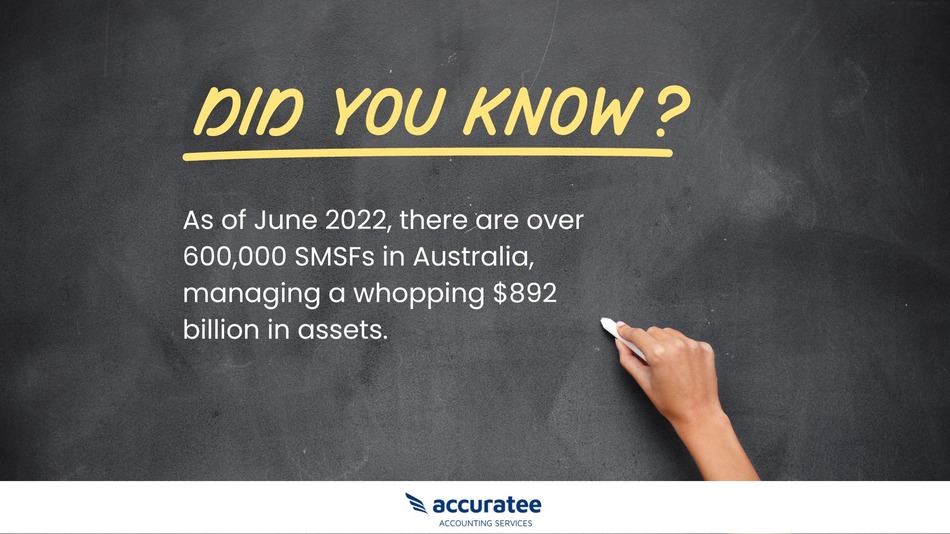Achieving financial independence: How to set up an SMSF in 8 steps?
Introduction:
In today's fast-paced world, taking control of your financial future has become more important than ever. An SMSF offers a unique opportunity to gain autonomy over your retirement savings, enabling you to make informed investment decisions tailored to your specific goals.
In this comprehensive guide, we will walk you through eight essential steps to set up your SMSF successfully. From understanding the fundamentals of an SMSF to selecting suitable trustees, choosing investments, and navigating compliance requirements, we will provide you with the knowledge and insights necessary to embark on this empowering journey.
By the end of this blog, you will have a clear roadmap to establish your SMSF, empowering you to take charge of your financial destiny and work towards achieving long-term financial independence. Let's dive in!
Key takeaways
Self-managed superannuation fund is a type of superannuation fund that gives members greater control over their retirement savings.
Setting up an SMSF allows individuals to tailor their investment portfolios to their personal preferences and financial goals.
Compliance with superannuation laws and regulations is essential throughout the SMSF setup and ongoing management.
Expert SMSF advice is crucial to navigate complexities, ensure compliance, and meet legal and regulatory requirements.
What is SMSF?
SMSF, or self-managed superannuation fund, is a type of superannuation fund that gives members greater control over their retirement savings. This type of fund enables members to directly manage their investments and make strategic decisions based on their individual investment goals.
SMSFs can have up to four members, and each member is also a fund trustee, which makes them responsible for complying with the rules and regulations set out by the Australian Taxation Office.
While SMSFs offer many benefits, it is important to consider the risks and responsibilities of managing your superannuation fund before making any decisions. Professional advice should be sought to determine whether an SMSF is right for you.

What are the benefits of setting up SMSF?
Setting up an SMSF (Self-Managed Super Fund) can benefit those who choose to take control of their retirement savings. One of the key benefits is the level of flexibility provided, as SMSF members have the freedom to invest in a wide range of assets, from residential or commercial property to stocks and bonds.
This allows investors to tailor their portfolios to their personal preferences and financial goals. SMSFs also offer transparency and control over investments, allowing members to monitor the performance of their investments and make decisions accordingly.
Additionally, SMSFs can provide significant tax concessions, with contributions and investment income taxed at a concessional rate of 15%. Despite the additional responsibility of managing an SMSF, consulting an SMSF tax accountant can help ensure compliance with all legal and regulatory requirements while maximizing the potential tax benefits.
Eight steps to set up Self Managed Super Fund (SMSF)
Setting up a Self-Managed Super Fund (SMSF) is a complex and involved process. To simplify the process, we’ve outlined eight essential steps to help you set up your SMSF successfully.

Step 1: Choose your trustee
To set up a family, unit, or discretionary trust, you'll need to designate SMSF trustees who will help manage and safeguard the account in case of any future incidents. You can choose to select individual or corporate trustees from your business.
Individual trustees are a group of two to six people. Each fund member must serve as a trustee, and all trustees must also be members of the fund. Another member cannot employ members unless they are relatives. Depending on where you live, state or territory laws may limit the number of trustees a trust can have.
Alternatively, you can appoint a corporate trustee, a company responsible for managing the fund. Like individual trustees, a corporate trustee must have up to six members. However, each fund member must also serve as a director of the corporate trustee, and all directors must also be fund members.
Additionally, the directors of corporate trustees need to have a director identification number (directory ID). The same rule about employment applies to corporate trustee members: they cannot be employed by another member unless they are relatives.
Step 2: Appoint trustee/director:
Once you have chosen your SMSF trustee, the next step is to appoint them. This may involve signing a trust deed, which outlines the roles and responsibilities of all trustees involved and sets out how the fund will be managed. Additionally, corporate trustees must register with the relevant government body and obtain a director identification number (directory ID).
Lastly, the trustee must be granted certain powers, including the ability to invest in assets and receive contributions for members. This will help ensure that all trust regulations are followed. Finally, trustees should ensure that they remain up-to-date with their obligations secured by law.
Step 3: Create a trust and trust deed
The next step is to create a trust and trust deed. A trust involves a trustee holding assets for the benefit of beneficiaries. A super fund, a specific type of trust, is created solely to provide retirement benefits to its members. Creating a trust requires trustees, governing rules, assets, and identifiable beneficiaries.
An SMSF trust deed is a legal document that specifies the rules for establishing and operating a fund, such as its goals, member eligibility, and benefit payout methods. It is crucial to have the deed prepared by a qualified individual, signed and executed by all trustees following state laws, and regularly reviewed and updated as necessary to ensure compliance.
Step 4: Check your fund is an Australian super fund
Once you have appointed your trustee and created a trust, the next step is to check that your fund qualifies as an Australian super fund. This means confirming that it meets the eligibility criteria for being classified as an SMSF. Generally, this involves ensuring that members are a maximum of four and that the fund has fewer than five trustees.
Additionally, an SMSF must not be established to provide financial assistance to related parties, such as business partners or family members. Finally, ensuring that all members have their own superannuation account linked to the fund is important. This will help ensure that you comply with SMSF regulations.
Expert Bookkeeping at Your Fingertips!
Step 5: Register your fund
The next step is to register your fund. This process involves lodging an application form with the Australian Taxation Office (ATO). This form must include information about the trustees, members, and fund assets. Additionally, it is important to provide the ATO with evidence that the trust deed meets all relevant superannuation laws and regulations.
Once your fund has been registered, you can start investing in assets and receiving contributions from members. It is also important to keep track of all transactions the fund makes and regularly report them to the ATO. This will help ensure that your fund remains compliant with all relevant regulations.
Step 6: Open a bank account
To manage the operations of your self-managed super fund (SMSF), you must open a unique bank account in the fund's name. This account will accept contributions, rollovers, and income from investments and pay for expenses and liabilities.
The bank account must be separate from the trustees' and related employers' bank accounts. You do not need a separate account for each member, but you must keep a separate record of each member's contributions and investments.
You can notify the Australian Taxation Office (ATO) of your fund's bank account details through a registered agent or online services for business by calling the ATO or lodging an SMSF Annual Return (SAR). The ATO will send you an alert via email or text message when changes are made to the SMSF bank account details.
Step 7: Get an electronic service address
If your self-managed super fund (SMSF) receives contributions from employers, it must be able to receive the contributions and associated SuperStream data electronically. SuperStream is a data and payment standard for super transactions, including employer contributions and rollovers between funds.
To use SuperStream, your SMSF needs an electronic service address (ESA), different from an email address. Your ESA must be compliant to accept rollovers for any super to or from your SMSF. Your administrator may provide you with an ESA, or you can use a SuperStream message solution provider. Once you have an ESA, you must update your records with the necessary authorities.
Step 8: Prepare an exit strategy
Even when setting up your SMSF, you must consider your exit strategy. This will help you prevent any future disputes and ensure the smooth transition of assets when members decide to leave or retire from the fund. Your SMSF's trust deed should include a clause stating how members' entitlements, such as their contributions, are to be managed if they decide to leave or retire from the fund.
You should also ensure that all members are aware of the exit strategy before they become members of your fund. Finally, you should also have a plan to appoint new trustees and replace existing ones who may no longer be able to fulfil their duties. This will help to ensure the ongoing smooth operation of your SMSF.
Conclusion
Achieving financial independence has never been easier with the right guidance and knowledge. Setting up an SMSF is a smart investment move towards achieving financial freedom and can be broken down into 8 simple steps.
To ensure you make the most out of your investments, it’s important to get professional advice from experienced advisers like CleanSlate. With our help, you can start your journey to building a secure financial future.
As important as superannuation is for your long-term retirement savings, many people don’t take the time to understand how it works or if they should take control of it through an SMSF. But SMSFs offer great flexibility and potential for strong returns in the future. Making that call today could set you on a path to achieving financial freedom.
At CleanSlate, our team of SMSF experts is highly qualified and motivated to assist you in understanding what best suits your individual circumstances and goals so that you can make the best decisions possible for yourself now and beyond.
So why wait? Contact CleanSlate today and begin taking advantage of all the opportunities that setting up an SMSF has to offer!


















